#Benz Patent Motorwagen
Explore tagged Tumblr posts
Text
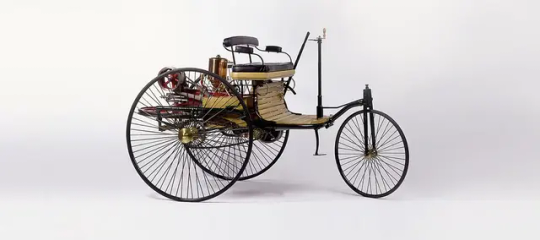
Benz Patent-Motorwagen: The world's first car, 1886.
#first ever#cars#vintage cars#classic cars#mercedes benz#mbz#mercedes#1886#horseless carriage#Benz Patent-Motorwagen#karl benz#automobile#benz velo#history
13 notes
·
View notes
Text

On the morning of August 5, 1888, Bertha Benz and her two oldest sons quietly left their house. While her husband Carl slept, she left a note saying they were going to visit her mother in Pforzheim, about 60 miles away. They pushed one of Carl’s Benz Patent-Motorwagens out of the workshop to avoid waking him before starting the engine. This marked the first long-distance journey by automobile, forever changing the course of transportation history.
447 notes
·
View notes
Text




Benz Patent-Motorwagen Replica. - source Bring a Trailer.
50 notes
·
View notes
Text
Tardwrangler Co had early Christmas party this year, and once again there was an amateur history quiz, which I will translate and share with my mutuals here. (partial previous)
For everyone bored by memorizing pointlessly exact dates - here we only ask about the century something happened in, which you can often reason about from general context knowledge, and the questions are a bit florid to give you some context. "Armenia converts to Christianity" is a free-floating factoid, the Armenia question below gives you clues about what it was before and after.
All answers are centuries AD.
The Roman Emperor Hadrian builds Hadrian's Wall in northern England to keep out barbarians, which is to say the Scots.
Armenia, east of Turkey, becomes the world's first country to convert to Christianity as state religion.
Attila the Hun, Scourge of God, rules and/or pillages half of Europe.
City of Baghdad founded by caliph Al-Mansur of the Abbasid Caliphate.
Vikings plunder the Lindisfarne monastery, signaling the start of the Viking Age and a lot more loot and plunder.
England's king Edward the Confessor dies, starting a free-for-all competition for the English crown, featuring Harold Godwinsson of England, Harald Hard-Ruler of Norway, Svein the Younger of Denmark, and William the Bastard of France. William wins and becomes William the Conqueror.
King Sigurd Magnusson is the first king of Norway to go to Jerusalem on a crusade-slash-pilgrimage, becomes known as Sigurd Jorsalfare (Goes-To-Jerusalem). Norwegians not very creative in their naming.
The French brothers Montgolfier invent and fly in a hot air balloon, arguably the first manned flight though that's disputed.
The German Karl Benz invents and drives the Benz Patent-Motorwagen, arguably the first car though that's even more disputed.
Norway wins its first gold medal at the Olympic Games.
Answers below the cut. Give yourself a point for every right answer, half a point for being "only a century" off. ;)
Hadrian's Wall 1XX (for nitpickers who say "the 100s" is a decade)
Armenia converts 3XX
Attilla the Hun 4XX
Baghdad founded 7XX
Viking looting spree 7XX
William the Conqueror of England 10XX
Sigurd goes to Jerusalem 11XX
Montgolfier flight 17XX
Benz drives 18XX
Norwegian gold 19XX.
11 notes
·
View notes
Text

Visitors are greeted by an unusual exhibit - an exact copy of the Benz Patent-Motorwagen, Karl Benz's car, with which our automobile world as such began more than a century ago. It is curious that even the Mercedes-Benz factory museum also has only a copy: the original tricycle is kept in the German Museum of Natural Sciences in Munich.
4 notes
·
View notes
Text
The world's first car
There is much controversy surrounding the world's first car because, in the late 19th century, several inventors and engineers were working on self-driving vehicles at the same time. However, Karl Benz was one of the earliest and most influential pioneers in automobile development.
Karl Benz, a German engineer, crafted a revolutionary invention in 1885-1886, the Benz Patent-Motorwagen. This vehicle, widely acknowledged as the first actual automobile, was a game-changer in transportation. It was the first vehicle designed to be propelled by an internal combustion engine, boasting three wheels, a single-cylinder engine, and a top speed of around 10 miles per hour.
The Benz Patent-Motorwagen was not only a vehicle; it also brought about a significant advance in transportation technology. It is marked as the beginning of the automotive industry as we know it today. It has unveiled a gateway to advancement and innovation in the automobile engineering sector. Its influence can still be seen in the cars we see on the road today; it has acted as a true game-changer in the history of the automobile.
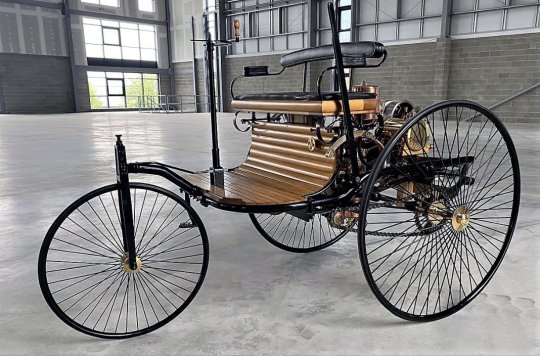
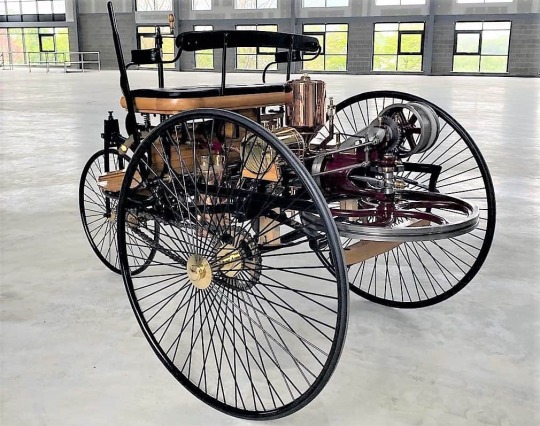

#cars#luxury car#classic car#vintage cars#car accessories#benz#mercedes benz#automotive engineering#automotive#automobile#auto parts#carparts
8 notes
·
View notes
Text
catch me rolling up in the benz patent motorwagen
3 notes
·
View notes
Text
I Like Cars
A car or an automobile is a vehicle that has wheels. It carries a small number of passengers and is moved by an engine or a motor. Cars also make very cool noises, like revving. Cars can go very fast, like the Bugatti Chiron and other cars. Some cars are also very slow, like the P50. Some cars are also big, and some cars are small.
Some of my dream cars are Toyota Hilux and Subaru Brz. The car brands I like are Toyota, Lamborghini, and Ferrari. There are also different types of cars, like sedans, hatchbacks, coupes, SUVs, and sportcars. Cars are a practical, marketable automobile for everyday use.
A history about cars. Are was invented in 1886, when the German inventor Carl Benz patented his Benz Patent Motorwagen.

So that is my blog about cars thank you.
2 notes
·
View notes
Text
The Evolution of Automobiles: A Journey Through Time

Introduction
The history of automobiles is a fascinating tale of innovation, determination, and human ingenuity. From the earliest steam-powered contraptions to the sleek electric vehicles of today, cars have shaped our lives, economies, and landscapes. Let’s embark on a journey through time to explore the milestones, inventors, and revolutions that define the world of automobiles.
1. The Pioneers
a. Nicolas-Joseph Cugnot and the Steam Carriage (1769)
In a small workshop in France, Nicolas-Joseph Cugnot built the first self-propelled vehicle. His steam-powered carriage, known as the “Fardier à vapeur,” could carry passengers and cargo. Although slow and cumbersome, it marked the birth of the automobile.
b. Karl Benz and the Benz Patent-Motorwagen (1886)
Fast-forward to the late 19th century. Karl Benz, a German engineer, unveiled the Benz Patent-Motorwagen. It was the first true automobile powered by an internal combustion engine running on gasoline. With three wheels, a single-cylinder engine, and a top speed of 16 km/h (10 mph), the Motorwagen revolutionized transportation.
2. The Model T Era
a. Henry Ford and the Model T (1908)
Henry Ford’s vision was to make cars accessible to everyone. In 1908, he introduced the Model T, an affordable, mass-produced vehicle. The assembly line revolutionized manufacturing, and soon, millions of Model Ts rolled off the production line. The car became a symbol of progress and freedom.
3. The Roaring Twenties and Streamlined Designs
a. Art Deco and Streamlining
The 1920s witnessed a shift in car design. Art Deco influences brought elegance and symmetry to automobile aesthetics. Streamlining, inspired by aviation, emphasized sleek curves and aerodynamic shapes. Cars like the Chrysler Airflow and the Bugatti Type 57 exemplified this trend.
4. Post-War Boom and Muscle Cars
a. Post-World War II Boom
After World War II, car production soared. Families embraced sedans like the Chevrolet Bel Air and the Ford Fairlane. The 1950s saw tailfins, chrome, and optimism. Drive-in theaters and roadside diners became part of the American dream.
b. Muscle Cars and Horsepower Wars
The 1960s brought muscle cars—powerful, V8-engine beasts. The Ford Mustang, Chevrolet Camaro, and Dodge Charger ruled the streets. The horsepower wars escalated, and drag racing became a cultural phenomenon.
5. Environmental Concerns and Innovations
a. Oil Crisis and Compact Cars
The 1970s oil crisis shifted priorities. Compact cars like the Volkswagen Beetle and Toyota Corolla gained popularity. Fuel efficiency and emissions control became critical.
b. Hybrid and Electric Cars
In the 21st century, environmental awareness led to hybrid and electric vehicles. The Toyota Prius pioneered hybrid technology, while Tesla’s electric cars redefined performance and sustainability.
6. The Road Ahead: Autonomous Vehicles and Beyond
a. Autonomous Driving
Self-driving cars are no longer science fiction. Companies like Waymo and Tesla are pushing the boundaries of autonomy. The future promises safer roads and shared mobility.
b. Sustainability and Beyond
As we move forward, sustainability remains paramount. Hydrogen fuel cells, solar-powered cars, and urban mobility solutions will shape the next chapters in automotive history.
Conclusion
From steam carriages to electric supercars, the automobile’s evolution mirrors our progress as a society. Each turn of the wheel brings new challenges, innovations, and dreams. So, fasten your seatbelt—we’re still on an exhilarating ride
4 notes
·
View notes
Text
A Look at Mercedes’ Electric Future: The EQ Series
The Evolution of Mercedes: From Classics to Modern Marvels
Mercedes-Benz is more than just a luxury car brand—it’s a symbol of innovation, performance, and prestige that has shaped the automotive industry for over a century. From its early roots in classic automobiles to the modern marvels gracing today’s roads, Mercedes has remained a pioneering force, consistently blending timeless elegance with cutting-edge technology. This blog takes you on a journey through the evolution of Mercedes-Benz, highlighting key milestones that have solidified its reputation as an icon of the automotive world.
The Early Days: Birth of a Legend
Mercedes-Benz traces its origins back to the late 19th century when Karl Benz and Gottlieb Daimler laid the foundation for modern automobiles. In 1886, Karl Benz created the Benz Patent-Motorwagen, often considered the first true automobile. Around the same time, Daimler and Wilhelm Maybach built a vehicle with a gasoline-powered engine. These early developments set the stage for the future of Mercedes-Benz.
The brand's official birth came in 1926 when Daimler-Motoren-Gesellschaft (DMG) merged with Benz & Cie to form Mercedes-Benz. The combination of the two companies brought together their strengths in engineering and innovation, establishing a brand that would redefine luxury and performance in the automotive world.
1930s: Setting Standards with the Mercedes 500K and 540K
The 1930s saw Mercedes-Benz rise to prominence as a producer of high-performance, luxury vehicles. The Mercedes 500K and 540K models became symbols of automotive excellence, featuring powerful engines, streamlined designs, and unparalleled craftsmanship. These models were the epitome of luxury, favored by royalty, celebrities, and influential figures of the time. The 540K, with its supercharged 5.4-liter engine, became an icon, blending speed with opulence in a way that few others could match.
1950s: The Birth of an Icon with the 300SL
Fast-forward to the post-World War II era, and Mercedes-Benz continued to push boundaries with the introduction of the Mercedes 300SL in 1954. Known for its distinctive gullwing doors, the 300SL was the fastest production car of its time and the first to feature direct fuel injection. This iconic sports car not only redefined speed and performance but also embodied the elegance and sophistication that would become synonymous with the Mercedes brand.
The 300SL also set the stage for Mercedes’ dominance in motorsport, especially in Formula One and endurance racing, further cementing its reputation as a leader in performance engineering.
1960s-1980s: Innovation and Expansion
The mid-20th century saw Mercedes-Benz expanding its lineup to cater to a broader audience. The introduction of the Mercedes S-Class in the 1970s revolutionized the luxury sedan segment, becoming the benchmark for comfort, safety, and technological innovation. With features like anti-lock brakes (ABS), airbags, and advanced suspension systems, Mercedes made safety a key component of luxury.
During this period, Mercedes also introduced the G-Class (G-Wagen) in 1979, a rugged, military-inspired SUV that quickly became a favorite for off-road enthusiasts while still delivering the luxury and quality expected from the brand.
1990s: A New Era of Performance with AMG
In the 1990s, Mercedes-Benz entered a new era of performance with its acquisition of AMG, a tuning company that specialized in high-performance variants of Mercedes models. The collaboration brought the birth of the Mercedes-AMG lineup, featuring powerful V8 engines and enhanced driving dynamics. Models like the AMG E55 and the AMG C36 became favorites for drivers seeking both luxury and blistering performance.
The AMG division quickly grew into a central part of the brand’s identity, representing the pinnacle of performance engineering while maintaining Mercedes’ commitment to comfort and style.
2000s-Present: Redefining Luxury and Technology
The 21st century has been marked by a continued push for innovation. Mercedes-Benz has seamlessly integrated advanced technology into its vehicles, offering drivers a suite of features designed for convenience, safety, and entertainment. Innovations such as the Mercedes-Benz User Experience (MBUX) system, semi-autonomous driving capabilities, and active safety features like collision prevention and lane-keeping assist have become standard in many models.
Mercedes has also embraced the electric future with the introduction of its EQ lineup. The Mercedes EQS, launched in 2021, represents the brand’s commitment to sustainability without compromising on luxury or performance. With its fully electric drivetrain, cutting-edge battery technology, and premium interior, the EQS positions Mercedes at the forefront of the electric vehicle revolution.
Mercedes Today: A Symbol of Prestige
Today, Mercedes-Benz stands as a global leader in the luxury automobile industry, continuously setting benchmarks in performance, safety, and technology. Whether it's the elegance of the S-Class, the versatility of the G-Class, or the eco-conscious innovation of the EQ series, Mercedes-Benz has mastered the art of blending tradition with modernity.
Conclusion: A Legacy of Excellence
From the early days of Karl Benz’s first motor vehicle to the cutting-edge electric cars of the 21st century, Mercedes-Benz has evolved into an automotive powerhouse. Its legacy is built on a commitment to pushing the boundaries of design, engineering, and luxury. As the brand continues to innovate and adapt to new technologies, one thing remains clear: Mercedes-Benz will always be a symbol of excellence and a leader in the automotive world.

1 note
·
View note
Text
have you guys seen the original Benz patent motorwagen it’s silly as HELL looking. It looks like. Animal. Or bug I don’t know if I saw someone using that back then I’d laugh in the middle of the street
4 notes
·
View notes
Text

Bertha Benz (German: [ˈbɛʁta ˈbɛnts] i; née Cäcilie Bertha Ringer; 3 May 1849 – 5 May 1944) was a German automotive pioneer.
She was the business partner and wife of automobile inventor Carl Benz.
On 5 August 1888, she was the first person to drive an internal-combustion-engined automobile over a long distance, field testing the Benz Patent-Motorwagen, inventing brake lining and solving several practical issues during the journey of 105 km (65 miles).
In doing so, she brought the Patent-Motorwagen worldwide attention and got the company its first sales. Via Wikipedia
2 notes
·
View notes
Text

The animal I chose to depict is an elephant. Here's five facts about elephants:
Elephants are the world's largest land mammal. An average male elephant can be up to 3 meters (13 ft.) tall and weigh up to 6 tonnes.
The two main species of elephants are African Elephants and Asian Elephants. African Elephants are distinctly larger in size and have bigger ears. Asian Elephants are smaller and have more rounded ears. Asian Elephants also have only one spike at the tip of their trunk while African Elephants have two.
Elephants communicate using seismic signals. They create vibrations in the ground which other elephants detect and absorb through their feet and bones.
Elephant family units are matriarchal. The matriarch of an elephant unit is typically the oldest and largest adult female member of the family. They are the ones responsible for providing stability and conflict resolutions.
Elephants are vegetarians. Their entire diet consists of roots, grasses, fruits, and bark. An adult elephant can consume up to 300 pounds of food in a single day.
Source: https://earth.org/facts-about-elephants/
Here are some facts about the modern technology depicted as well:
The Concorde is a retired Franco-British supersonic airliner which could maintain speeds of up to Mach 2.04 (2,170 km/h) at an altitude of 60,000 ft. To date, it is one of only two supersonic airliners to see regular service. (https://en.wikipedia.org/wiki/Concorde, https://en.wikipedia.org/wiki/Supersonic_transport).
The IBM 3380 was the world's first gigabyte-capacity disk drive. It was released in 1980 and weighed 455 kg (1000 lbs). Two 1.26 GB head disk assemblies were packaged in a cabinet the size of a refrigerator. At the time, it was priced at $81k, which is the modern day equivalent of about $287k. (https://en.wikipedia.org/wiki/History_of_hard_disk_drives#:~:text=1980%20%E2%80%93%20The%20IBM%203380%20was,first%20gigabyte%2Dcapacity%20disk%20drive.).
Wristwatches were initially designed for women. Men used pocket watches, instead. (https://myjewelryrepair.com/2019/02/12-interesting-facts-about-timepieces/).
The form of the digital tablet was first conceptualized in the 1968 science fiction film, 2001: A Space Odyssey. It was then prototyped and developed in the last two decades of the 20th century. The iPad, released by Apple, was the first mass-market tablet to achieve widespread popularity. (https://en.wikipedia.org/wiki/Tablet_computer)
The Benz Patent-Motorwagen is widely regarded as the first practical modern automobile. Built in 1885 by Karl Benz, it was the first car put into production. The original cost of the vehicle in 1886 was $150 USD (equivalent to $4900 in 2022). (https://en.wikipedia.org/wiki/Benz_Patent-Motorwagen).
2 notes
·
View notes
Text

Visitors are greeted by an unusual exhibit - an exact copy of the Benz Patent-Motorwagen, Karl Benz's car, with which our automobile world as such began more than a century ago. It is curious that even the Mercedes-Benz factory museum also has only a copy: the original tricycle is kept in the German Museum of Natural Sciences in Munich.
2 notes
·
View notes
Text

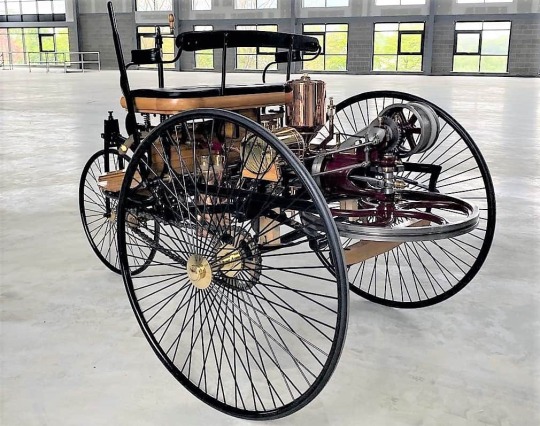
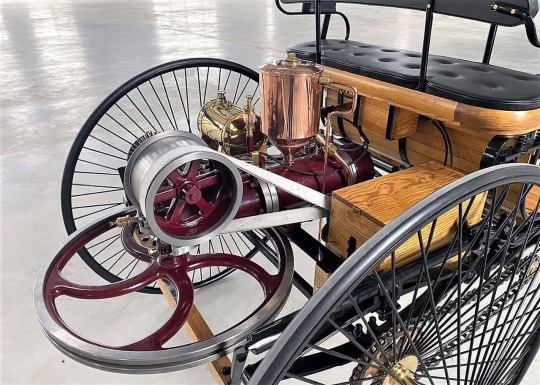
The world's first car
There is much controversy surrounding the world's first car because, in the late 19th century, several inventors and engineers were working on self-driving vehicles at the same time. However, Karl Benz was one of the earliest and most influential pioneers in automobile development.
Karl Benz, a German engineer, crafted a revolutionary invention in 1885-1886, the Benz Patent-Motorwagen. This vehicle, widely acknowledged as the first actual automobile, was a game-changer in transportation. It was the first vehicle designed to be propelled by an internal combustion engine, boasting three wheels, a single-cylinder engine, and a top speed of around 10 miles per hour.
The Benz Patent-Motorwagen was not only a vehicle; it also brought about a significant advance in transportation technology. It is marked as the beginning of the automotive industry as we know it today. It has unveiled a gateway to advancement and innovation in the automobile engineering sector. Its influence can still be seen in the cars we see on the road today; it has acted as a true game-changer in the history of the automobile.
#cars#luxury car#classic car#vintage cars#car accessories#benz#mercedes benz#automotive engineering#automotive#automobile#auto parts#carparts
5 notes
·
View notes
Text
AutoTechnic
Automobile: Revolutionizing the Way We Move
The automobile is one of the most transformative inventions in human history. From its humble beginnings as a steam-powered carriage to today’s sleek, high-tech electric vehicles, the automobile has redefined transportation, reshaped cities, and fueled economic growth across the globe.
AutoTechnic
Today, cars are not just a means of getting from point A to point B—they represent freedom, innovation, personal expression, and, increasingly, a path toward a more sustainable future.
A Brief History of the Automobile
The first self-propelled vehicles emerged in the late 18th and early 19th centuries, powered by steam engines. However, the modern automobile as we know it was born in the late 1800s when Karl Benz patented the first gasoline-powered car—the Benz Patent-Motorwagen—in 1886.
The automobile industry exploded in the early 20th century with the introduction of mass production techniques, most famously by Henry Ford, whose assembly line model drastically reduced car prices and made vehicle ownership accessible to the average person.
Types of Automobiles
Over the years, automobiles have evolved into many forms to suit different needs and lifestyles. The most common categories include:
🚗 Sedans
Known for their comfort, fuel efficiency, and practicality—perfect for daily commuting.
🚙 SUVs (Sport Utility Vehicles)
Larger vehicles with more cargo space and off-road capability. Popular among families and outdoor enthusiasts.
🛻 Trucks
Designed for hauling and towing, these are ideal for commercial work and heavy-duty use.
🏎️ Sports Cars
Built for speed, performance, and style, these are the choice of driving enthusiasts.
⚡ Electric Vehicles (EVs)
Environmentally friendly, with zero tailpipe emissions. EVs are growing rapidly in popularity due to advances in battery technology and charging infrastructure.
How Automobiles Work: The Basics
A traditional gasoline-powered automobile includes:
Engine: Converts fuel into mechanical energy to move the car.
Transmission: Transfers engine power to the wheels.
Chassis: The structural framework that supports the car.
Suspension: Ensures a smooth ride by absorbing shocks.
Brakes: Essential for stopping safely.
Electronics: Modern vehicles are equipped with onboard computers, sensors, and infotainment systems.
Electric and hybrid vehicles use electric motors, batteries, and regenerative braking systems instead of or alongside traditional engines.
The Impact of Automobiles
🌍 Economic Growth
The auto industry supports millions of jobs globally—from manufacturing to sales, repair, and infrastructure development.
🏙️ Urban Development
Cities have been designed around cars for the past century, leading to highways, parking lots, and suburban expansion.
🌱 Environmental Concerns
Cars are a major contributor to air pollution and climate change, prompting a shift toward cleaner technologies like EVs and hydrogen fuel cells.
The Future of Automobiles
The automobile industry is undergoing a historic transformation with innovations such as:
Electric Vehicles (EVs) powered by renewable energy
Autonomous (self-driving) cars using AI and sensors
Connected vehicles that communicate with each other and the road
Shared mobility models like ride-sharing and car subscriptions
These changes are shaping a future that’s safer, smarter, and more sustainable.
AutoTechnic
Final Thoughts
From revolutionizing personal travel to becoming a symbol of freedom and innovation, the automobile has left a lasting impact on society. As we move forward into an era of clean energy and smart technology, the car continues to evolve—offering not just transportation, but a vision of progress and possibility.
Would you like this article tailored for a school report, blog post, or business website? I can adjust the tone and structure to fit your needs.
1 note
·
View note